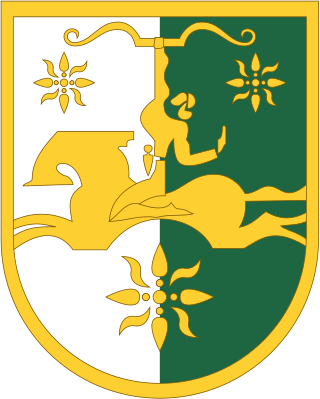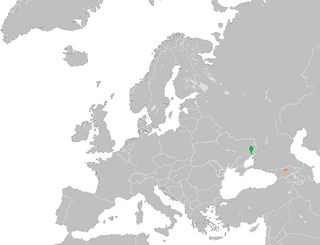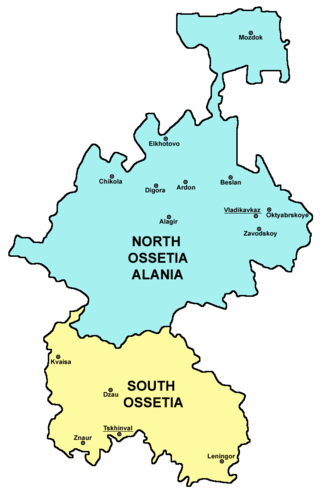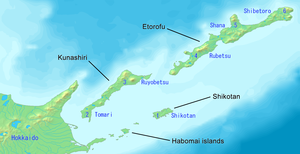
South Ossetia, officially the Republic of South Ossetia–State of Alania, is a partially recognised landlocked country in the South Caucasus. It has an officially stated population of just over 56,500 people (2022), who live in an area of 3,900 square kilometres (1,500 sq mi), with 33,000 living in the capital city, Tskhinvali.

An Autonomous Soviet Socialist Republic was a type of administrative unit in the Soviet Union (USSR), created for certain ethnic groups to be the titular nations of. The ASSRs had a status lower than the constituent union republics of the USSR, but higher than the autonomous oblasts and the autonomous okrugs.

The republics are one type of federal subject of the Russian Federation. 21 republics are internationally recognized as part of Russia; another is under its de facto control. The original republics were created as nation states for ethnic minorities. The indigenous ethnicity that gives its name to the republic is called the titular nationality. However, due to centuries of Russian migration, a titular nationality may not be a majority of its republic's population. By 2017, the autonomous status of all republics was formally abolished, making the republics politically equivalent to the other federal subjects of Russia.

UTC+03:00 is an identifier for a time offset from UTC of +03:00. In areas using this time offset, the time is three hours ahead of the Coordinated Universal Time (UTC). Following the ISO 8601 standard, a time with this offset would be written as, for example, 2019-02-08T23:36:06+03:00.

The borders of Russia changed through military conquests and by ideological and political unions from the 16th century.

The Transnistria conflict is an ongoing frozen conflict between Moldova and the unrecognized state of Transnistria. Its most active phase was the Transnistria War. There have been several attempts to resolve the conflict, although none have been successful. The conflict may be considered as having started on 2 September 1990, when Transnistria made a formal sovereignty declaration from Moldova.

The Republic of Abkhazia is a partially recognized state in the South Caucasus which declared independence from Georgia during the War in Abkhazia (1992–1993). At the time, the Soviet Union had recently collapsed (1991).

On 17 February 2008, the majority of members of the Assembly of Kosovo, including Hashim Thaçi, and Fatmir Sejdiu, not acting in the capacity of PISG, declared Kosovo an independent and sovereign state. Kosovo was soon recognized as a sovereign state by the United States, Turkey, Albania, Austria, Germany, Italy, France, the United Kingdom, the Republic of China (Taiwan), and others. This triggered an international debate over whether Kosovo's unilateral declaration of independence had set a precedent in international law that could apply to other separatist movements, or whether it is a special case. The recognition of Kosovo's independence by 101 out of 193 UN states, according to many sources, has given fresh impetus to other separatist movements.

Administrative divisions development in Ukraine reviews the history of changes in the administrative divisions of Ukraine, in chronological order.

Russian-occupied territories in Georgia are areas of Georgia that have been occupied by Russia since the Russo-Georgian War in 2008. They consist of the regions of the Autonomous Republic of Abkhazia and the former South Ossetian Autonomous Region of Soviet Georgia, whose status is a matter of international dispute.

Donetsk People's Republic–South Ossetia relations are the bilateral relations between the Donetsk People's Republic (DPR) and South Ossetia. The DPR is a disputed republic of Russia whereas South Ossetia is a partially recognized state. From April 2014 to September 2022, the DPR portrayed itself as an independent state, but this is no longer the case after Russia's annexation of the DPR on 30 September 2022.

Russian irredentism refers to territorial claims made by the Russian Federation to territories that were historically part of the Russian Empire and the Soviet Union, which Russian nationalists refer to as the "Russian world". It seeks to politically incorporate ethnic Russians and Russian speakers living in neighbouring territories outside Russia's modern-day borders. This ideology has been significantly defined by the regime of Vladimir Putin, who has governed the country since 1999.

Independence Day or Republic Day is the main state holiday in the partially recognized Republic of South Ossetia. This date is celebrated on September 20. It commemorates South Ossetia's declaration of independence from the Georgian SSR in 1990, and the country's recognition as a sovereign state by Russia in 2008.

The government of Transnistria, a breakaway state internationally recognized as part of Moldova, has requested annexation by Russia numerous times. Transnistria is a territory that separated itself from Moldova due to fear of a possible unification of the latter with Romania. This sparked the Transnistria War, in which Russian-backed Transnistria managed to stay separate from Moldova. Despite this, today Transnistria is legally and internationally considered part of Moldova.

South Ossetia is a partially recognized and Russian-occupied separatist state internationally recognized as part of Georgia. It is mainly inhabited by Ossetians, an ethnic group also dominant in North Ossetia, which is part of Russia. South Ossetia separated itself from Georgia following the 1991–1992 South Ossetia War with the help of Russia, remaining ever since as a state closely allied with this country.























